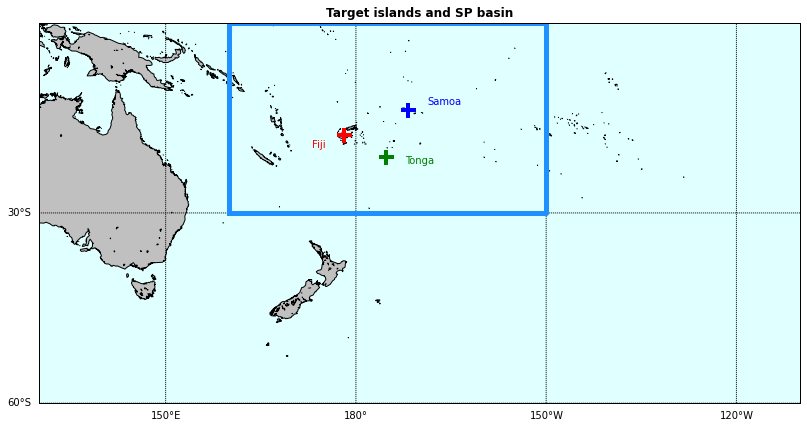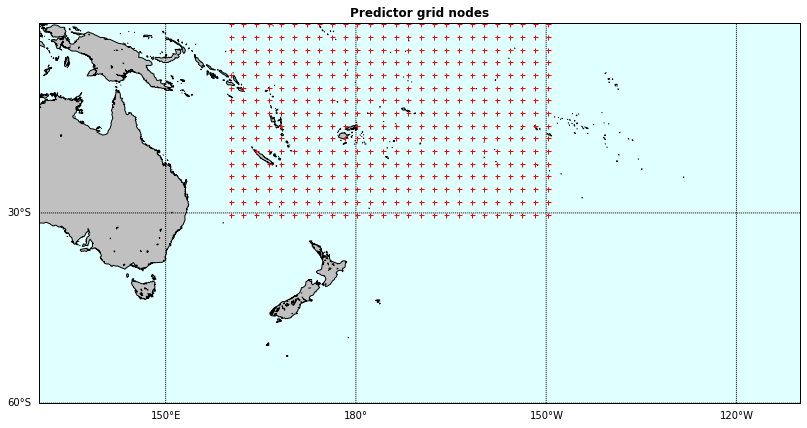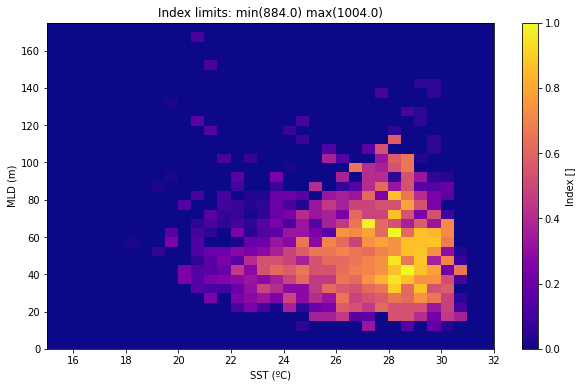Index Predictor Definition and Building
Contents
Index Predictor Definition and Building#
# common
import os
import os.path as op
import sys
import pickle as pk
# pip
import numpy as np
import xarray as xr
# DEV: bluemath
sys.path.insert(0, op.join(op.abspath(''), '..', '..', '..', '..'))
# bluemath modules
from bluemath.seasonal_forecast_tcs.ibtracs import load_storms_sp, extract_tcs_rectangle, ds_index_sst_mld_slp_pp_calibration,\
dataframe_pressures_ibtracs, add_sst_mld, data_to_discret, ds_index_sst_mld_calibration, ds_trmm
from bluemath.seasonal_forecast_tcs.plotting.site import Plot_target_area, Plot_predictor_grid
from bluemath.seasonal_forecast_tcs.plotting.ibtracs import Plot_ibtracs_sst_mlp_pmin, Plot_index
import warnings
warnings.filterwarnings("ignore")
Database and site parameters#
# database
p_data = r'/media/administrador/HD2/SamoaTonga/data'
site = 'SamoaTonga'
p_site = op.join(p_data, site)
# deliverable
p_deliv = op.join(p_site, 'seasonal_forecast_tcs')
# IBTrACS database
p_ibtracs = op.join(p_data, 'IBTrACS.ALL.v04r00.nc')
# daily mean SST and MLD
p_sst = '/media/administrador/HD1/DATABASES/SeasonalForecast_TCs/SST'
p_mld = '/media/administrador/HD1/DATABASES/SeasonalForecast_TCs/CFS/ocnmld'
# precipitation
p_trmm = '/media/administrador/HD1/DATABASES/SeasonalForecast_TCs/TRMM_daily'
# sea level pressure
p_slp = '/media/administrador/HD1/DATABASES/SeasonalForecast_TCs/CFS'
# output files:
p_out_pmin_sst_mld = op.join(p_deliv, 'df_coordinates_pmin_sst_mld.pkl')
p_out_pmin_sst_mld_2021 = op.join(p_deliv, 'df_coordinates_pmin_sst_mld_2021.pkl')
p_out_sst_mld_calibration = op.join(p_deliv, 'sst_mld_calibration.nc')
p_out_sst_mld_slp_calibration = op.join(p_deliv, 'sst_mld_slp_calibration.nc')
p_out_trmm = op.join(p_deliv, 'xs_trmm.nc')
if not op.isdir(p_deliv):
os.makedirs(p_deliv)
# predictor parameters
lo_area = [160, 210]
la_area = [-30, 0]
lo_SP, la_SP = [130, 250], [-60, 0]
lop = 160.25
lop2 = 211
lap = -0.25
lap2 = -32
delta = 2
# ibtracs v4 dictionary
d_vns = {
'longitude': 'lon',
'latitude': 'lat',
'time': 'time',
'pressure': 'wmo_pres',
}
# calibration years index
y_cali_index = 5184
Spatial and temporal domain#
The predictor area spans around the islands of Tonga, Samoa and Fiji, from latitude 0º to 30º and from longitude 160º to 210º; far enough to be able to identify regional as well as local patterns. The calibration period (time domain) is defined from 1982 to 2019.
Plot_target_area(rectangle=[lo_area[0], lo_area[1], la_area[0], la_area[1]]);

The variables required for the methodology are downloaded from the databases:
Predictand: Tropical cyclones tracks from IBTrACs, for the minimum pressure point.
Predictor: NOAA 1/4º daily Optimum Interpolation Sea Surface Temperature (SST) and Mixed Layer Depth (MLD) from the NCEP Climate Forecast System Reanalysis (CFSR).
xds_ibtracs, xds_SP = load_storms_sp(p_ibtracs)
All basins storms: 13549
SP basin storms: 1130
# extract TCs inside rectangle, 772 a 780
TCs_rect_hist_tracks = extract_tcs_rectangle(
xds_SP,
lo_area[0], lo_area[1], la_area[0], la_area[1],
d_vns,
)
df0 = dataframe_pressures_ibtracs(xds_ibtracs)
df0[6000:6010]
| st | time | lon | lat | pres | |
|---|---|---|---|---|---|
| 6000 | 9832 | 1987-02-12 12:00:00.000040448 | 139.125000 | -15.225000 | 970.0 |
| 6001 | 9832 | 1987-02-12 18:00:00.000040448 | 139.817963 | -15.790068 | 970.0 |
| 6002 | 9832 | 1987-02-13 00:00:00.000040448 | 140.160004 | -16.719999 | 970.0 |
| 6003 | 9832 | 1987-02-13 06:00:00.000040448 | 140.032623 | -17.892567 | 980.0 |
| 6004 | 9832 | 1987-02-13 12:00:00.000040448 | 139.699997 | -19.200003 | 996.0 |
| 6005 | 9832 | 1987-02-13 18:00:00.000040448 | 139.480362 | -20.108568 | 998.0 |
| 6006 | 9832 | 1987-02-14 00:00:00.000040448 | 139.399994 | -21.100000 | 1001.0 |
| 6007 | 9834 | 1987-02-07 12:00:00.000040448 | 161.800003 | -13.050001 | 990.0 |
| 6008 | 9834 | 1987-02-07 18:00:00.000040448 | 163.449997 | -13.150000 | 995.0 |
| 6009 | 9834 | 1987-02-08 00:00:00.000040448 | 166.242844 | -14.371429 | 997.0 |
# TODO guardar df_2021 antes de hacer este corte de tiempo, despues guardar el cortado como df_2019
df0 = df0[(df0['time'] < '2021-01-31 ')]
df = add_sst_mld(df0, p_sst, p_mld, lo_area[0], lo_area[1], la_area[0], la_area[1])
# years of the calibration period
df_cali = df.drop(df.index[y_cali_index:])
# show data
df.tail()
# store dataframe
with open(p_out_pmin_sst_mld_2021, 'wb') as f:
pk.dump(df, f)
Start time: 2022-03-28 16:34:01.168824
End time: 2022-03-28 16:38:07.860781
For the calibration period the points with pressure, SST and MLD data in the target area are kept.
# TODO mld database stops at 2021-02-01, use only df0 data till 2020
df0 = df0[(df0['time'] < '2020-01-01 ')]
df = add_sst_mld(df0, p_sst, p_mld, lo_area[0], lo_area[1], la_area[0], la_area[1])
# years of the calibration period
df_cali = df.drop(df.index[y_cali_index:])
# show data
df.tail()
# store dataframe
with open(p_out_pmin_sst_mld, 'wb') as f:
pk.dump(df, f)
print(df)
Start time: 2022-03-28 16:38:27.970073
End time: 2022-03-28 16:42:15.958994
st time lon lat pres \
4471 9245 1981-12-18 12:00:00.000040448 172.000000 -9.000000 997.0
4472 9245 1981-12-19 00:00:00.000040448 169.950012 -9.450001 997.0
4473 9245 1981-12-19 12:00:00.000040448 169.000000 -9.800001 990.0
4474 9245 1981-12-20 00:00:00.000040448 168.199997 -11.000000 987.0
4475 9245 1981-12-20 12:00:00.000040448 167.399994 -12.200000 980.0
... ... ... ... ... ...
14687 13353 2019-12-31 06:00:00.000039936 185.616379 -20.368277 999.0
14688 13353 2019-12-31 09:00:00.000039936 186.182968 -20.301870 999.0
14689 13353 2019-12-31 12:00:00.000039936 186.849609 -20.312431 1000.0
14690 13353 2019-12-31 15:00:00.000039936 187.731110 -20.379351 1000.0
14691 13353 2019-12-31 18:00:00.000039936 188.699997 -20.499998 1001.0
sst mld
4471 29.580000 64.541672
4472 27.840000 80.874992
4473 28.859999 66.666664
4474 28.719999 68.333336
4475 28.750000 56.750000
... ... ...
14687 25.750000 40.666668
14688 25.199999 43.166664
14689 26.049999 42.666664
14690 27.029999 35.708336
14691 26.430000 42.999996
[5311 rows x 7 columns]
Predictor grid and data processing#
The historical datasets are interpolated into the a 1/2º grid resolution, defining this way the grid for the predictor in the target area.
Plot_predictor_grid(delta, lop, lop2, lap, lap2, lo_SP, la_SP);

MLD, SST and Pmin data plotted after preprocessing (left) and the same data after discretization in intervals of 0.5 m and 0.5ºC respectively (right):
Plot_ibtracs_sst_mlp_pmin(df);

Index definition and computation#
The historic datasets are combined into the tailor-made index predictor. It is built from the combination of SST-MLD-Pmin of the coordinate dataset previously generated. For simplicity the index will range from 0 to 1, so the pressure range is rescaled in this range.
# discretization: 0.5ºC (SST), 5m (MLD)
xx, yy, zz = data_to_discret(
df['sst'].values, df['mld'].values, 0.5, 5,
df['pres'].values, 15, 32, 0, 175,
option = 'min',
)
# index function
index = zz
fmin, fmax = np.nanmin(zz), np.nanmax(zz)
index_zz = (fmax - index) / (fmax-fmin)
# remove nan
index_zz[np.isnan(index_zz)] = 0
The index predictor function:
indexi = (Pmax - Pi) / (Pmax - Pmin)
The index plotted in the MLD-SST space:
Plot_index(xx, yy, zz, index_zz);

Final dataset including all the variable and the index predictor values in the predictor grid.
xs = ds_index_sst_mld_calibration(p_sst, p_mld, df, lop, lop2, lap, lap2, delta)
print(xs)
# store output
xs.to_netcdf(p_out_sst_mld_calibration)
Start time: 2022-03-28 16:42:17.003093
End time: 2022-03-28 16:42:19.678729
Merge time: 2022-03-28 17:06:20.837717
<xarray.Dataset>
Dimensions: (lat: 16, lon: 26, time: 13879)
Coordinates:
* time (time) datetime64[ns] 1982-01-01 1982-01-02 ... 2019-12-31
* lat (lat) float64 -0.25 -2.25 -4.25 -6.25 ... -26.25 -28.25 -30.25
* lon (lon) float64 160.2 162.2 164.2 166.2 ... 204.2 206.2 208.2 210.2
Data variables:
index (time, lat, lon) float64 0.3667 0.05833 0.0 ... 0.1167 0.2417 0.0
sst (time, lat, lon) float32 30.77 30.95 30.03 ... 23.1 22.85 22.9
dbss (time, lat, lon) float32 19.38 28.42 76.08 ... 24.33 23.88 19.75
mask (lat, lon) float64 0.0 0.0 0.0 0.0 0.0 0.0 ... 0.0 0.0 0.0 0.0 0.0
xs_f = ds_index_sst_mld_slp_pp_calibration(p_slp,xs,lop,lop2,lap,lap2,delta)
print(xs_f)
# store output
xs_f.to_netcdf(p_out_sst_mld_slp_calibration)
Start time: 2022-03-28 17:06:42.644581
End time: 2022-03-28 17:06:45.370540
Merge time: 2022-03-28 17:14:12.342342
<xarray.Dataset>
Dimensions: (lat: 16, lon: 26, time: 13879)
Coordinates:
* time (time) datetime64[ns] 1982-01-01 1982-01-02 ... 2019-12-31
* lat (lat) float64 -0.25 -2.25 -4.25 -6.25 ... -26.25 -28.25 -30.25
* lon (lon) float64 160.2 162.2 164.2 166.2 ... 204.2 206.2 208.2 210.2
Data variables:
index (time, lat, lon) float64 0.3667 0.05833 0.0 ... 0.1167 0.2417 0.0
sst (time, lat, lon) float32 30.77 30.95 30.03 ... 23.1 22.85 22.9
dbss (time, lat, lon) float32 19.38 28.42 76.08 ... 24.33 23.88 19.75
mask (lat, lon) float64 0.0 0.0 0.0 0.0 0.0 0.0 ... 0.0 0.0 0.0 0.0 0.0
slp (time, lat, lon) float32 1.01e+05 1.01e+05 ... 1.009e+05 1.011e+05
# extract TRMM
xs_trmm = ds_trmm(p_trmm, lop, lop2, lap, lap2, delta)
print(xs_trmm)
# store output
xs_trmm.to_netcdf(p_out_trmm)
Start time: 2022-03-28 17:14:12.403624
End time: 2022-03-28 17:14:14.614323
Merge time: 2022-03-28 17:22:01.740134
<xarray.Dataset>
Dimensions: (lat: 16, lon: 26, time: 8034)
Coordinates:
* time (time) datetime64[ns] 1998-01-01 1998-01-02 ... 2019-12-30
* lat (lat) float64 -0.25 -2.25 -4.25 ... -26.25 -28.25 -30.25
* lon (lon) float64 160.2 162.2 164.2 166.2 ... 206.2 208.2 210.2
Data variables:
precipitation (time, lat, lon) float32 2.46 0.18 0.84 1.2 ... 0.0 0.0 0.0

